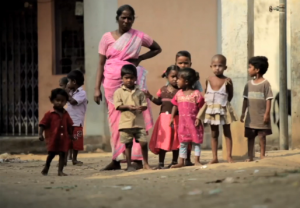The Indian woman who is featured in It’s a Girl for killing eight of her own newborn daughters has generated a lot of hostility.
Many of the hundreds of comments on the It’s a Girl trailer on YouTube reflect anger and disbelief:
“The woman laughing while saying that she killed eight of her children just makes me sick…”
“wtf..is she a mother?? how can someone kill eight children..man this is sick..”
“… brought me chills. I am going to have nightmares about her.”
“…pink lady needs a beating!”
“Those who kill these baby girls should be killed!!! There are no excuses for this kind of cruelty.”
“WTH is wrong with that woman?????”
These responses are understandable. How can a woman kill her own children and seemingly have no regret? Some viewers, though, were able to look beneath the surface of her smile and discern more:
“…her smile should hide her despair …. well hidden … how sad …”
“I understand people being upset by the woman’s laughter at the end of the video. I think she was reacting in the same way we all do when we are embarrassed or ashamed. Imagine living in a culture where this callous act was expected of you. So very sad.”
“It’s important to understand that mothers are living under larger power structures that force them to take such drastic measures. This doesn’t happen in a vacuum, they dont just wake up one day and decide to kill their daughters…its much larger than that. It’s patriarchy, colonialism, capitalism. etc, etc,…”
While we all agree that there is nothing that can justify or excuse what this village woman did, we need to ask ourselves if we would have acted differently had we been in her shoes. The fact of the matter is that we are all a product of our environment. And the environment that produced this woman is a brutal, female-hating culture. She grew up bound by traditional mores that say girls are of no value. A woman marries into her husband’s family, becoming little more than a possession, and bearing a son or bringing a large dowry are the only two ways a woman can elevate herself within the family system.
Our environment (the physical, intellectual, emotional and spiritual influences that surround us throughout life) heavily influences our values and belief system as adults. This woman grew up in a patriarchal, son-preferential culture. She is programed to believe that “Raising a daughter is like watering your neighbor’s garden” (an Indian proverb), because, in India, a daughter leaves her family and becomes a member of her husband’s family upon marriage. And she takes a large part of her family’s wealth with her in the form of dowry.
This village woman is a little unusual in that she had gone to middle school – something most girls in her area don’t have the privilege of doing. But her older sister, who married a land-owner in her community, was unable to have children, and it was decided that she would also marry her sister’s husband to bear him children. She was 15 at the time. Her “job” as his second wife was to bear him a son– and she took it seriously.
Later in the film, the village woman sings a song about her plight as a woman in India. It is a sad song about loss and regret.
I can only imagine that her inability to comprehend the value of the lives of her eight daughters is rooted in a complete absence of value for herself. After all, she is a product of her environment and the culture in which she lives.
The question that remains for me is, when an entire social and economic machine like the Indian culture wages war on girls, is change possible and if so, where does change start?
Originally posted on Evan’s personal blog at http://evangraedavis.com/

 We’re excited to announce that It’s a Girl has officially launched our partnership
We’re excited to announce that It’s a Girl has officially launched our partnership  We are honored to be selected for Amnesty International’s 2012 REEL AWARENESS film festival in Toronto.
We are honored to be selected for Amnesty International’s 2012 REEL AWARENESS film festival in Toronto.  Girls are the most marginalized and discriminated group across the globe. 70% of the 1 billion people living in extreme poverty in the world are women. 60 million girls are forced into marriage before the age of 18. One in three girls in the developing world, as young as 7 to 10 years old, face being forced into marriage every day. These child brides are two times as likely to be beaten by their husbands, are often treated as property, and rarely see the opportunity to get an education.
Girls are the most marginalized and discriminated group across the globe. 70% of the 1 billion people living in extreme poverty in the world are women. 60 million girls are forced into marriage before the age of 18. One in three girls in the developing world, as young as 7 to 10 years old, face being forced into marriage every day. These child brides are two times as likely to be beaten by their husbands, are often treated as property, and rarely see the opportunity to get an education.
